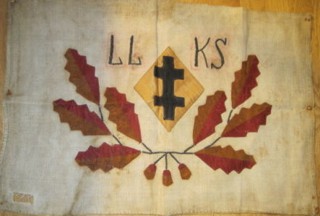 zachary harden
zachary harden
Keywords: lithuania |
Links: FOTW homepage | search | disclaimer and copyright | write us | mirrors

Last modified: 2023-06-03 by  zachary harden
zachary harden
Keywords: lithuania |
Links: FOTW homepage |
search |
disclaimer and copyright |
write us |
mirrors
See also:
19th regiment of Lithuanian uhlans (19-as Lietuvos ulonu
pulkas) - The cloth with two points is made up of four equal
horizontal bands: red, white, red, and white. The flag is drawn
according to my personal observation in exposition
"Napoleonas ir Lietuva" (Napoleon and Lithuania),
National Museum of Lithuania, Vilnius.
Anon., 23 July 2003

image by William Garrison, 01 April 2015
This flag was used by the Lithuanian Liberation army that fought the
Germans in 1942 to 1944 and Soviets from 1944 until 1955. They are
also known as the "Forest Brothers". Size 25' x 16.5' .
William Garrison, 01 April 2015
This flag was sold on Ebay during the past year. The seller could be Ilja
Shapiro. I have bought another Forest brothers flag from the same seller a
couple of years ago. It is a very strange, because nobody in the Lithuanian
Forest Brothers Museum knows any information about these flags, standards and so
on. Lithuania didn't have any original flag with symbols LLKS (Lietuvos Laisves
Kovotoju Sajudis). These flags didn't appear in any Forest Brothers photos. It
is a very strange, because one eBay guy during 3 years has found and sold 3 of
them (the third he tried to sell this past month) My flag looks really old, and
I do not have any arguments for telling that it is a fake... Maybe you have a
more info about these type of flags?
Note: flags with lists of oak and symbols of LLKS have been used (if it
isn't fakes!) only in 1949-1953 because this organisation (LLKS) was made in
1949.
Saulius Poderis, 14 December 2015
This flag would actually be the flag of the LLKS (Lietuvos laisvės kovos
sąjūdis, Union of Lithuanian Freedom Fighters or Movement for the Struggle for
Lithuanian Freedom in English). It was a resistance organization of the
Lithuanian partisans, waging a guerrilla war against the
Soviet Union after the
occupation and even after the end of World War II. The organization was
established on February 10, 1949, during a meeting of all partisan
commanders in Minaičiai village. Jonas Žemaitis (codename Vytautas)
was elected as the chairman of its presidium. On February 16, the 21st
anniversary of the 1918 Act of Independence of Lithuania, the Union
adopted a declaration proclaiming itself to be the supreme political
and military authority in Lithuania. In 1996, after Lithuania regained
independence in 1990, the Seimas (parliament) recognized the
declaration as an official act of the Republic of Lithuania and
Žemaitis as President of Lithuania. The organization and the partisan war were suppressed by the Soviet
security agencies by 1953.
The flag features the
Lithuanian partisans symbol.
The term "Forest Brothers" first came into use in the Baltic region
(Estonia, Latvia, Lithuania) during the chaotic Russian
Revolution of 1905. Varying sources refer to forest brothers of this
era either as peasants revolting or as schoolteachers seeking refugee
in the forest. Hence, the geographical location of the forrests in
Lithuania, became proper ground to wage guerrilla warfare later during
World War II and the occupation by
Soviet and
German forces according to
the Molotov-Ribbentrop pact
Source: http://en.wikipedia.org/wiki/Forest_Brothers
The Forest Brothers were actually one of the many Lithuanian and
Polish partisans (such as the "Cursed soldiers", Żołnierze wyklęci in
Polish) that fought in the Baltic Region.
Source: http://en.wikipedia.org/wiki/Lithuanian_partisans
Additional sources:
https://ru.wikipedia.org/wiki/Лесные_братья_(1940—1957)
http://en.wikipedia.org/wiki/Union_of_Lithuanian_Freedom_Fighters ,
http://en.wikipedia.org/wiki/Lithuanian_partisans
http://en.wikipedia.org/wiki/Forest_Brothers
Esteban Rivera, 14 December 2015
I found this flag.
Source:
http://www.gzeme.lt/?s_id=1&n_id=7044
It bears the logo of the miško broliai or Forrest Brothers. Now: I don't
know if this flag really existed, or if it's a reenactment group featuring its
own flag or a veterans' association of former forrest brothers fighters, but to
me it is most likely a reenactment group. Again, I don't know if the flag is
vintage or if it's a modern creation to identify the group.
There's also this website, where
you can find further information on this topic. It stands for: - Promoting the
Lithuanian resistance movement during WWII and postwar years and its linking
with (the city of) Ukmerge.
- Promoting and communicating Lithuanian resistance movement activities during
WWII and postwar years.
- Participating in other organized historical battlefields.
- Communicating with other military history clubs exchanging information and
experience.
- Allowing club members and sponsors a significant way to participate and gain
interest during their leisure time.
Source:
http://miskobroliai.weebly.com/apie-klub261.html
The above mentioned "club" (group) has its own
Facebook page for
additional information.
They feature
original pictures of "forrest brothers" partisans.
Since the area of operations of these groups were the Baltic countries, they
were also referred to as
Metsavennad in Estonian and even had a group called
Metsavendlus Eestis.
It is worth noticing that the armed resistance against Nazi occupation during
WWII evolved and continued to be an armed resistance against Soviet occupation
after WWII ended, by this group. Thus, this armed resistance movement known as "Forrest
Brothers", is actually an amalgamation of several groups (by no means an
umbrella organization, but rather a "term" to indicate armed resistance against
a foreign occupation) in the Baltic countries (Estonia, Latvia and Lithuania) of
combatants that fought for many years, even after WWII ended.
Esteban Rivera, 14 December 2015